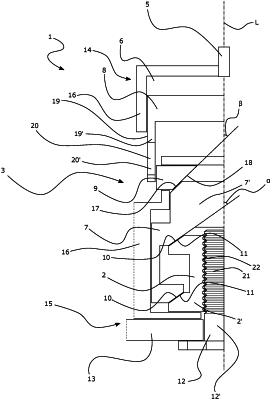| CPC B64G 1/645 (2013.01) | 11 Claims |

|
1. A separation device for a spacecraft or launcher, the separation device being movable from a locked state, in which the separation device is arranged to lock onto a component of said spacecraft or launcher, to a released state, in which said component is released, said separation device comprising:
an inner housing divided into at least two portions for locking onto said component of said spacecraft or launcher,
a locking arrangement arranged to move between a locking configuration and a releasing configuration, wherein the locking configuration is such that said at least two portions of said inner housing are prevented from separating, and
at least one initiator that provides high pressure fluid to an expansion chamber when the separation device is moved from the locked state to the released state, wherein the high pressure fluid in said expansion chamber moves the locking arrangement from the locking configuration to the releasing configuration;
wherein said locking arrangement comprises:
a first part arranged to at least partially enclose said at least two portions of said inner housing when said locking arrangement is in the locking configuration, wherein said inner housing comprises at least one angled abutment surface arranged to abut at least one abutment surface on the first part when the locking arrangement is in the locking configuration,
a piston arranged at least partially inside said expansion chamber, and
at least one locking element which is held between said first part and said piston when said locking arrangement is in the locking configuration, thereby preventing said first part from releasing said at least two portions of said inner housing.
|